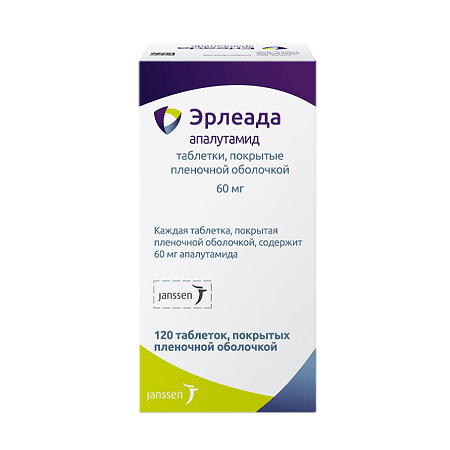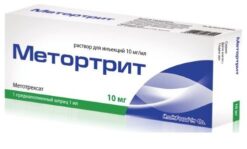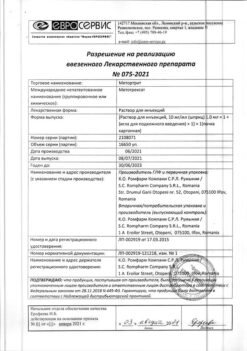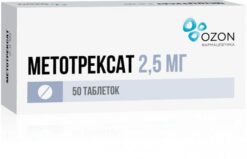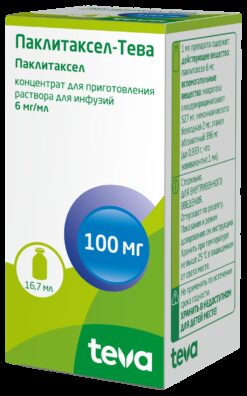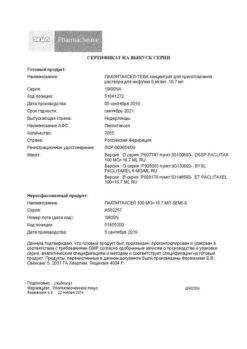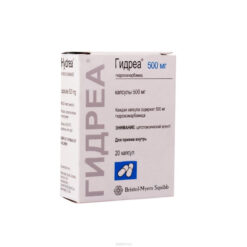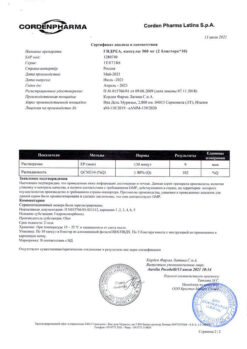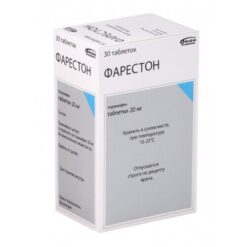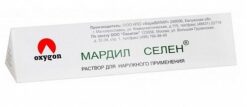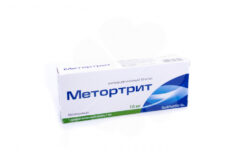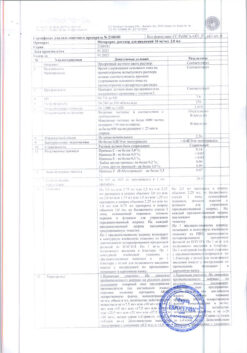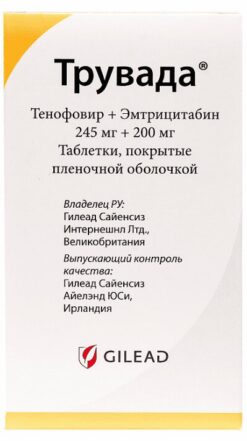No products in the cart.
Description
Pharmacotherapeutic group: antitumor agent, antiandrogen.
The ATX code: L02BB05
Pharmacological properties
Mechanism of action
Apalutamide is an orally taken selective androgen receptor inhibitor that binds directly to the ligand-binding domain of the androgen receptor. Apalutamide inhibits nuclear translocation of the androgen receptor, inhibits DNA binding, disrupts androgen receptor-mediated transcription and has no activity as an androgen receptor agonist – noted in preclinical studies.
In murine models of prostate cancer, administration of apalutamide led to a decrease in proliferation of tumor cells and an increase in apoptosis, which was accompanied by significant antitumor activity. The activity of the main metabolite, N-desmethylapalutamide, was one third of the in vitro activity of apalutamide.
Pharmacodynamics
Heart electrophysiology
The effect of apalutamide at a dose of 240 mg once daily on the QTc interval was studied in an open, uncontrolled, multicenter QT interval study in one group of 45 participants with castration-resistant PPH. The maximum mean change in the QTcF interval from baseline was 12.4 ms (upper limit of two-sided 90% CI: 16.0 ms). Analysis of the relationship between systemic exposure and the QT interval suggested a concentration-dependent prolongation of the QTcF interval of apalutamide and its active metabolite.
Pharmacokinetics
An increase in systemic apalutamide levels (Cmax and area under the concentration-time curve [AUC [AUC]) within the dose range of 30 to 480 mg. After using the drug at a dose of 240 mg once daily, equilibrium levels of apalutamide were reached after 4 weeks, and the average cumulation ratio compared with a single application was 5.
At equilibrium, the mean (CV%) Cmax and AUC values for apalutamide were 6 µg/mL (28%) and 100 µg×h/mL (32%), respectively. Daily fluctuations in plasma concentrations of apalutamide were small, with a mean ratio between peak and minimum concentrations of 1.63. There was an increase in apparent clearance (CL/F) with repeated administration, which is probably due to the induction by apalutamide of its own metabolism.
At equilibrium, the mean (CV%) Cmax and AUC values for the major active metabolite, N-desmethylapalutamide, were 5.9 µg/mL (18%) and 124 µg×h/mL (19%), respectively. N-desmethylapalutamide was characterized by a horizontal concentration-time dependence profile at equilibrium with an average peak-to-minimum concentration ratio of 1.27. The mean (CV%) metabolite/source drug AUC ratio for N-desmethylapalutamide after multiple administration was approximately 1.3 (21%). Based on systemic levels, relative activity, and pharmacokinetic properties, it is likely that N-desmethylapalutamide contributes to the clinical activity of apalutamide.
Intake
After oral administration, the median time to peak plasma concentration (tmax) was 2 hours (range: 1 to 5 hours). Mean absolute bioavailability with oral administration was approximately 100%, which corresponds to complete absorption of apalutamide after oral administration.
The administration of apalutamide to healthy volunteers on an empty stomach and after a high-fat meal was not accompanied by clinically relevant changes in Cmax and AUC. There was an increase in median time to reach tmax by approximately 2 hours after ingestion of the drug with food.
Distribution
The mean apparent volume of distribution of apalutamide at equilibrium is approximately 276 L. The distribution volume of apalutamide exceeds the total fluid volume, indicating significant extravascular distribution.
The apalutamide and N-desmethylapalutamide are 96% and 95% bound to plasma proteins, respectively; binding is predominantly to plasma albumin and is independent of concentration.
Metabolism
After a single oral dose of 240 mg of labeled 14C-apalutamide, most of the 14C-radioactivity in plasma was due to apalutamide, the active metabolite N-desmethylapalutamide and the inactive carboxylic acid derivative, which were associated with 45%, 44% and 3% of the total 14C-AUC, respectively.
Metabolism is the major route of elimination of apalutamide. Metabolism is predominantly carried out by CYP2C8 and CYP3A4 isoenzymes with the formation of N-desmethylapalutamide. Further metabolism of apalutamide and N-desmethylapalutamide occurs with the formation of an inactive carboxylic acid derivative under the action of carboxylesterase. The contribution of CYP2C8 and CYP3A4 isoenzymes to the metabolism of apalutamide is 58% and 13% after single use, and it is 40% and 37% respectively when used repeatedly at equilibrium.
Apalutamide is excreted, primarily as metabolites, mainly in the urine. After a single oral administration of radiolabeled apalutamide, 89% of the dose was excreted up to 70 days after drug administration. 65% of the dose was excreted in the urine (1.2% as the parent substance, 2.7% as N-desmethylapalutamide) and 24% in the feces (1.5% as the parent substance, 2% as N-desmethylapalutamide).
After a single dose, the CL/F value of apalutamide was 1.3 L/h, with an increase in this value to 2 L/h at equilibrium with once-daily administration. The average effective half-life of apalutamide at equilibrium is approximately 3 days.
Particular patient populations
Patients with impaired renal and hepatic function
No significant differences in the pharmacokinetics of apalutamide and N-desmethylapalutamide were observed in patients with mild renal impairment (estimated glomerular filtration rate (pSCF) 60-89 mL/min/1.73 m2) or moderate renal impairment (rGFR 30-59 mL/min/1.73 m2), mild renal impairment (Child-Pugh class A) or moderate renal impairment (Child-Pugh class B), for ages ranging from 18 to 94 years and for various races.
The potential effect of severe renal dysfunction or end-stage renal failure (rCF ≤ 29 mL/min/1.73 m2) has not been established due to insufficient data. Clinical and pharmacokinetic data are not available for patients with severe hepatic impairment (Child-Pugh class C).
Indications
Indications
Erleada is indicated for the treatment of adult men with:
· non-metastatic castration-resistant prostate cancer (PCa) with a high risk of metastases;
· metastatic hormone-sensitive prostate cancer in combination with androgen deprivation therapy (ADT).
Pharmacological effect
Pharmacological effect
Pharmacotherapeutic group: antitumor agent, antiandrogen.
ATX code: L02BB05
Pharmacological properties
Mechanism of action
Apalutamide is an orally administered selective androgen receptor inhibitor that binds directly to the ligand binding domain of the androgen receptor. Apalutamide interferes with androgen receptor nuclear translocation, inhibits DNA binding, disrupts androgen receptor-mediated transcription, and has no androgen receptor agonist activity in preclinical studies.
In mouse models of prostate cancer, administration of apalutamide led to a decrease in tumor cell proliferation and an increase in apoptosis, which was accompanied by significant antitumor activity. The activity of the main metabolite, N-desmethylapalutamide, was one third of the in vitro activity of apalutamide.
Pharmacodynamics
Electrophysiology of the heart
The effect of apalutamide 240 mg once daily on the QTc interval was studied in an open-label, single-arm, multicenter QTc interval study of 45 participants with castration-resistant prostate cancer. The maximum mean change in QTcF interval from baseline was 12.4 ms (upper limit of two-sided 90% CI: 16.0 ms). When analyzing the relationship between systemic exposure and the QT interval, a concentration-dependent prolongation of the QTcF interval was suggested for apalutamide and its active metabolite.
Pharmacokinetics
With repeated once-daily dosing, a dose-proportional increase in systemic levels of apalutamide (Cmax and area under the concentration-time curve [AUC]) was observed over a dose range of 30 to 480 mg. After administration of the drug at a dose of 240 mg 1 time per day, the achievement of equilibrium levels of apalutamide was noted after 4 weeks, and the average accumulation ratio compared with a single dose was 5.
At steady state, the mean (CV%) Cmax and AUC values for apalutamide were 6 μg/ml (28%) and 100 μg x h/ml (32%), respectively. Diurnal variations in plasma concentrations of apalutamide were small, with a mean ratio between peak and trough concentrations of 1.63. With repeated use, an increase in apparent clearance (CL/F) was noted, which is likely due to apalutamide’s induction of its own metabolism.
At steady state, the mean (CV%) Cmax and AUC values for the major active metabolite, N-desmethylapalutamide, were 5.9 μg/mL (18%) and 124 μg·h/mL (19%), respectively. N-desmethylapalutamide exhibits a horizontal concentration-time profile at steady state with an average peak-to-trough concentration ratio of 1.27. The mean (CV%) metabolite/parent drug AUC ratio for N-desmethylapalutamide after multiple doses was approximately 1.3 (21%). Based on systemic levels, relative potency, and pharmacokinetic properties, it is likely that N-desmethylapalutamide contributes to the clinical activity of apalutamide.
Suction
Following oral administration, the median time to peak plasma concentration (tmax) was 2 hours (range: 1 to 5 hours). The mean absolute oral bioavailability was approximately 100%, which corresponds to complete absorption of apalutamide after oral administration.
Administration of apalutamide to healthy volunteers on an empty stomach and after a high-fat meal was not associated with clinically significant changes in Cmax and AUC. After taking the drug with food, an increase in the median time to reach tmax by approximately 2 hours was noted.
Distribution
The average apparent volume of distribution of apalutamide at steady state is approximately 276 L. The volume of distribution of apalutamide exceeds the total fluid volume, indicating significant extravascular distribution.
Apalutamide and N-desmethylapalutamide are 96% and 95% bound, respectively, to plasma proteins, binding predominantly to plasma albumin and independent of concentration.
Metabolism
Following a single 240 mg oral dose of 14C-labeled apalutamide, the majority of plasma 14C radioactivity was due to apalutamide, the active metabolite N-desmethylapalutamide, and the inactive carboxylic acid derivative, which accounted for 45%, 44%, and 3% of the total 14C-AUC, respectively.
Metabolism is the main route of elimination of apalutamide. Metabolism is predominantly carried out by the isoenzymes CYP2C8 and CYP3A4 with the formation of N-desmethylapalutamide. Subsequently, apalutamide and N-desmethylapalutamide are metabolized to form an inactive carboxylic acid derivative under the action of carboxylesterase. The contribution of the CYP2C8 and CYP3A4 isoenzymes to the metabolism of apalutamide is 58% and 13% after a single dose, and with repeated use at steady state it is 40% and 37%, respectively.
Removal
Apalutamide is excreted primarily as metabolites, mainly in the urine. Following a single oral dose of radiolabeled apalutamide, 89% of the dose was eliminated up to 70 days after dosing. Excretion of 65% of the dose occurred in urine (1.2% as parent material, 2.7% as N-desmethylapalutamide) and 24% in feces (1.5% as parent material, 2% as N-desmethylapalutamide).
After a single dose, the CL/F value of apalutamide was 1.3 l/h, with this value increasing to 2 l/h at steady state with the drug taken once a day. The mean effective half-life of apalutamide at steady state is approximately 3 days.
Special patient populations
Patients with impaired renal and liver function
There were no significant differences in the pharmacokinetics of apalutamide and N-desmethylapalutamide in patients with mild renal impairment (estimated glomerular filtration rate (eGFR) 60-89 ml/min/1.73 m2) or moderate renal impairment (eGFR 30-59 ml/min/1.73 m2), mild hepatic impairment (Child class A). – Pugh) or moderate liver dysfunction (Child-Pugh class B), for ages ranging from 18 to 94 years and for different races.
The potential impact of severe renal impairment or end-stage renal disease (eGFR ≤ 29 ml/min/1.73 m2) was not determined due to insufficient data. For patients with severe hepatic impairment (Child-Pugh class C), clinical and pharmacokinetic data are not available.
Special instructions
Special instructions
Convulsions
Erleada is not recommended in patients with a history of seizures or other predisposing factors, such as traumatic brain injury, recent stroke (within one year), primary brain tumors or brain metastases. If convulsions develop while using Erleada, the use of the drug should be permanently discontinued. The risk of seizures is higher in patients receiving additional drugs that lower the seizure threshold.
In two randomized trials (SPARTAN and TITAN), seizures were reported in 0.4% of patients receiving Erleada and 0.2% of patients receiving placebo. These studies excluded patients with a history of seizures or predisposing factors for them.
There is no clinical experience with restarting Erleada in patients who have experienced seizures.
Falls and fractures in patients with non-metastatic castration-resistant prostate cancer
In a randomized clinical trial of patients with non-metastatic castration-resistant prostate cancer treated with Erleada (SPARTAN), falls and fractures were reported (see Adverse Reactions). The risk of falls and fractures should be assessed before using Erleada, patients should be monitored during treatment, and the use of specialized bone medications should be considered.
Ischemic cardiovascular events in patients with metastatic hormone-sensitive prostate cancer
In the randomized trial in patients with metastatic hormone-sensitive prostate cancer (TITAN), cardiovascular ischemic events occurred in 4% of patients receiving Erleada and 2% of patients receiving placebo. 2 patients in each group died due to ischemic events from the cardiovascular system. The majority of patients in the TITAN study had cardiovascular risk factors.
Patients with metastatic hormone-sensitive prostate cancer should be monitored for coronary artery disease and managed based on cardiovascular risk factors, such as hypertension, diabetes mellitus, or dyslipidemia, according to the standard of care.
Concomitant use with other drugs
Apalutamide is a potent enzyme inducer and may reduce the effectiveness of many commonly used drugs (see Interactions with Other Drugs). Therefore, the use of concomitant medications should be reviewed before initiating treatment with apalutamide. Concomitant use of Erleada with drugs that are sensitive substrates of multiple metabolizing enzymes or transporters should be avoided if their therapeutic effect is of great importance to the patient and if dose adjustments cannot be easily made based on monitoring of efficacy or plasma concentrations.
The combined use of Erleada with warfarin and coumarin-like anticoagulants should be avoided. If Erleada is co-administered with an anticoagulant metabolized by CYP2C9 (such as warfarin or acenocoumarol), additional monitoring of the international normalized ratio (INR) should be performed (see Interactions with Other Drugs).
Recent cardiovascular disease
Patients with clinically significant cardiovascular disease occurring within the past 6 months, including severe/unstable angina, myocardial infarction, symptomatic congestive heart failure, arterial or venous thromboembolic events (eg, pulmonary embolism, cerebrovascular accidents, including transient ischemic attacks), or clinically significant ventricular arrhythmias, were excluded from clinical trials. research. Therefore, the safety of Erleada in these patients has not been established. When prescribing Erleada, patients should be monitored for cardiovascular risk factors such as hypercholesterolemia, hypertriglyceridemia, or other cardiometabolic disorders (see Adverse Reactions). These pathological conditions should be treated as necessary, after starting the use of Erleada, according to the established treatment protocol.
Antiandrogen therapy may prolong the QT interval
In patients with a history of prolonged QT interval or relevant risk factors, as well as in patients receiving concomitant medications that may prolong the QT interval (see Interactions with Other Drugs), the benefit-risk ratio, including the potential for torsade de pointes (TdP), should be assessed before initiating Erleada therapy.
Impact on the ability to drive vehicles and other mechanisms
Studies have not been conducted to study the effect of Erleada on the ability to drive vehicles or operate machinery. There is no information that Erleada affects the ability to drive vehicles or operate machinery. Given the profile of side effects, including the occurrence of seizures, caution should be exercised when driving vehicles and engaging in other potentially hazardous activities that require increased concentration and speed of psychomotor reactions.
Active ingredient
Active ingredient
Apalutamide
Composition
Composition
1 tablet contains:
Core
Active ingredient: apalutamide 60 mg.
Excipients: hypromellose acetate succinate, colloidal silicon dioxide, croscarmellose sodium, microcrystalline cellulose type 101, microcrystalline cellulose (silanized), magnesium stearate.
Film casing
Opadry® II 85F210036 green (polyvinyl alcohol, partially hydrolyzed, titanium dioxide, macrogol, talc, iron oxide yellow, iron oxide black).
Pregnancy
Pregnancy
Pregnancy
Erleada should not be used during pregnancy or if it is possible. Information on the mechanism of action suggests that taking Erleada during pregnancy may adversely affect the condition of the fetus. There is insufficient data on the use of Erleada during pregnancy. There have been no studies of the effect of Erleada on reproductive function and fetal development in animals.
Contraception
Erleada may be harmful to the developing fetus. Patients who have sexual intercourse with fertile partners should use highly effective methods of contraception throughout treatment, as well as for 3 months after taking the last dose of the drug.
Breastfeeding period
It is not known whether apalutamide or its metabolites passes into breast milk or has an effect on the health of breast-fed infants or on the mother’s milk production.
Fertility
An animal study showed that Erleada may reduce fertility in fertile men.
Contraindications
Contraindications
• Women of childbearing age, pregnant women
• Hypersensitivity to the active substance or any excipient of the drug
• Children under 18 years of age
• Severe renal and liver dysfunction
With caution
In patients at risk of developing seizures or with a history of seizures, at risk of falls and fractures; combined use with drugs that are substrates of CYP3A4 enzymes (for example, darunavir, felodipine, midazolam, simvastatin), CYP2C19 (for example, diazepam, omeprazole), CYP2C9 (for example, warfarin, phenytoin), UDP-glucuronosyltransferase (UGT) (for example, levothyroxine, valproic acid), with P-glycoprotein (P-gp) transporter substrate drugs (eg, colchicine, dabigatran etexilate, digoxin), breast cancer resistance protein (BCRP), or organic anion transport polypeptide 1B1 (OATP1B1) (eg, lapatinib, methotrexate, rosuvastatin, repaglinide), with an anticoagulant metabolized CYP2C9 (such as warfarin or acenocoumarol); in patients with clinically significant cardiovascular diseases that occurred within the last 6 months; in patients with a history of prolonged QT interval or relevant risk factors, as well as in patients receiving concomitant medications that may prolong the QT interval (see Precautions).
Side Effects
Side Effects
The most common adverse reactions were: fatigue (26%), skin rash (26% any grade and 6% grade 3 or 4), hypertension (22%), hot flashes (18%), arthralgia (17%), diarrhea (16%), falls (13%), and weight loss (13%). Other important adverse reactions include fractures (11%) and hypothyroidism (8%).
Adverse reactions observed during clinical trials are listed in the table below and divided into groups by frequency. By frequency, reactions are classified as follows: very frequent (≥ 1/10); frequent (≥ 1/100 – < 1/10); uncommon (≥ 1/1,000 – < 1/100); rare (≥ 1/10,000 – < 1/1,000); very rare (< 1/10,000) and unknown frequency (frequency cannot be estimated from available data).
In each frequency group, adverse reactions are presented in order of decreasing severity.
Table 1. Adverse reactions identified in clinical studies
Organ system class
Adverse reaction and frequency
Endocrine system disorders
Common: hypothyroidism*
Metabolic and nutritional disorders
Common: hypercholesterolemia, hypertriglyceridemia
Nervous system disorders
Common: dysgeusia
Uncommon: convulsions (see Special Instructions)
Heart disorders
Common: coronary heart disease§
Unknown: QT prolongation (see Special instructions, Interactions with other drugs)
Vascular disorders
Very common: hot flashes, hypertension
Gastrointestinal disorders
Very common: diarrhea
Skin and subcutaneous tissue disorders
Very common: skin rash**
Common: itching
Musculoskeletal and connective tissue disorders
Very common: fracture+, arthralgia
Common: muscle spasm
General and administration site disorders
Very common: fatigue
Laboratory and instrumental data
Very common: weight loss
Injuries, intoxications and complications of manipulations
Very common: falls
* Includes hypothyroidism, increased thyroid-stimulating hormone in the blood, decreased thyroxine, autoimmune thyroiditis, decreased free thyroxine levels, decreased triiodothyronine levels.
**See “Skin rash” in the “Description of selected adverse reactions” section
+ Observed in patients with non-metastatic castration-resistant prostate cancer. Includes rib fracture, lumbar vertebral fracture, vertebral compression fracture, vertebral fracture, foot fracture, hip fracture, humerus fracture, thoracic spine fracture, upper limb fracture, sacral fracture, arm fracture, pubic fracture, acetabulum fracture, ankle fracture, compression fracture, cartilaginous rib fracture, facial fracture, lower limb fracture, osteoporotic fracture, wrist fracture, avulsion fracture, fibula fracture, coccygeal fracture, pelvic fracture, radius fracture, sternum fracture, stress fracture, traumatic fracture, cervical spine fracture, femoral neck fracture, tibia fracture. See below Falls and fractures.
§ Observed in patients with metastatic hormone-sensitive prostate cancer. Includes angina pectoris, myocardial infarction, acute myocardial infarction, coronary artery occlusion, coronary artery stenosis, acute coronary syndrome, coronary artery atherosclerosis, abnormal exercise ECG results, myocardial ischemia.
Description of selected adverse reactions
Skin rash
Skin rash associated with Erleada use was most often described as a macular or maculopapular rash. Skin rash includes rash, maculopapular rash, generalized rash, urticaria, pruritic rash, macular rash, conjunctivitis, erythema multiforme, papular rash, skin peeling, genital rash, erythematous rash, stomatitis, drug rash, ulcerative stomatitis, pustular rash, blisters, papules, pemphigoid, skin erosion, dermatitis and vesicular rash. Adverse reactions in the form of skin rash were observed in 26% of patients receiving Erleada. Grade 3 rash (defined as covering >30% of the total body surface area) was noted in 6% of patients.
The median days until the onset of skin rash was 83 days. In 78% of patients, the rash resolved in an average of 78 days. Treatments for rash included topical corticosteroids, oral antihistamines, and 19% of patients received systemic corticosteroids. Among patients with skin rash, 28% temporarily stopped taking the drug and reduced the dose of the drug – 14% (see Dosage and Administration – Dose adjustment). The skin rash recurred in 59% of patients in whom the drug was reapplied after temporary cessation of therapy. Erleada was discontinued due to skin rash in 7% of patients.
Falls and fractures
In the ARN-509-003 clinical trial, fractures occurred in 11.7% of patients receiving Erleada and 6.5% of patients receiving placebo. Half of the patients had a fall within 7 days before the fracture in both treatment groups. Falls occurred in 15.6% of patients receiving Erleada and 9.0% of patients receiving placebo (see Precautions).
Hypothyroidism
Hypothyroidism, as assessed by thyroid-stimulating hormone (TSH) testing every 4 months, was reported in 8% of patients receiving Erleada and in 2% of patients receiving placebo. There were no grade 3 or 4 adverse events. The development of hypothyroidism was observed in 30% of patients already receiving thyroid hormone replacement therapy in the Erleada group and in 3% of patients in the placebo group. In patients without hormone replacement therapy, hypothyroidism developed in 7% of patients receiving Erleada and in 2% of patients receiving placebo. Thyroid hormone replacement therapy or dose adjustment of the drug should be started if clinically indicated (see Interactions with Other Medicines).
Interaction
Interaction
The metabolism of apalutamide and the formation of its active metabolite, N-desmethylapalutamide, is mediated at steady state by both the CYP2C8 and CYP3A4 isoenzymes to the same extent. Clinically significant changes in their overall exposure are not expected as a result of interaction of the drug with inhibitors or inducers of the CYP2C8 or CYP3A4 isoenzyme. Apalutamide is an enzyme and transporter inducer and may be responsible for increased elimination of many commonly used drugs.
Effect of other medicinal products on apalutamide exposure
CYP2C8 isoenzyme inhibitors
The CYP2C8 isoenzyme plays a role in the excretion of apalutamide and in the formation of its active metabolite. In a drug interaction study, a 21% decrease in apalutamide Cmax and a 68% increase in AUC were observed when a single 240 mg dose of Erleada was coadministered with gemfibrozil (a potent CYP2C8 inhibitor). For the active substance (sum of apalutamide and adjusted for active metabolite potency), Cmax decreased by 21%, while AUC increased by 45%. There is no need to adjust the initial dose when Erleada is co-administered with a strong CYP2C8 inhibitor (e.g. gemfibrozil, clopidogrel), however, a dose reduction of Erleada should be considered based on tolerability (see Dosage and Administration – Dosage Adjustment). It is assumed that weak or moderate inhibitors of the CYP2C8 isoenzyme do not affect the pharmacokinetics of apalutamide.
CYP3A4 isoenzyme inhibitors
The CYP3A4 isoenzyme plays a role in the excretion of apalutamide and in the formation of its active metabolite. In a drug interaction study, apalutamide Cmax was reduced by 22% while AUC remained unchanged when a single 240 mg dose of Erleada was coadministered with itraconazole (a strong CYP3A4 inhibitor). For the active substance (sum of apalutamide and adjusted for active metabolite potency), Cmax decreased by 22% while AUC remained unchanged. There is no need to adjust the initial dose when co-administering Erleada with a strong CYP3A4 inhibitor (e.g. ketoconazole, ritonavir, clarithromycin), however, a dose reduction of Erleada should be considered based on tolerability (see Dosage and Administration – Dosage Adjustment). It is assumed that weak or moderate inhibitors of the CYP3A4 isoenzyme do not affect the pharmacokinetics of apalutamide.
Inducers of the isoenzyme CYP3A4 or CYP2C8
The effects of inducers of CYP3A4 or CYP2C8 isoenzymes on the pharmacokinetics of apalutamide have not been assessed in in vivo studies. Based on the results of an interaction study with strong inhibitors of the isoenzyme CYP3A4 and CYP2C8, inducers of CYP3A4 or CYP2C8 are not expected to have clinically significant effects on the pharmacokinetics of apalutamide and the active substance, therefore, when co-administering Erleada with inducers of CYP3A4 or CYP2C8, no dose adjustment is required.
Effect of apalutamide on exposure to other drugs
Apalutamide is a potent enzyme inducer and increases the synthesis of many enzymes and transporters; therefore, apalutamide is expected to interact with many common drugs that are substrates of enzymes or transporters. The decrease in their plasma concentrations can be significant and lead to loss or reduction of the clinical effect. There is also a risk of increased formation of active metabolites.
Effect of apalutamide on drug metabolizing enzymes
In vitro studies have shown that apalutamide and N-desmethylapalutamide are moderate to strong inducers of CYP3A4 and CYP2B6, moderate inhibitors of CYP2B6 and CYP2C8, and weak inhibitors of CYP2C9, CYP2C19 and CYP3A4. Apalutamide and N-desmethylapalutamide do not affect the CYP1A2 and CYP2D6 isoenzymes at therapeutically significant concentrations. The effect of apalutamide on CYP2B6 substrates has not been assessed in vivo and the final outcome is currently unknown. When CYP2B6 substrates (eg, efavirenz) are coadministered with Erleada, monitor for adverse reactions and evaluate for loss of substrate efficacy, and substrate dosage adjustments may be necessary to maintain optimal plasma concentrations.
In humans, apalutamide is a strong inducer of the CYP3A4 and CYP2C19 isoenzymes and a weak inducer of the CYP2C9 isoenzyme. In a drug interaction study using a cocktail approach, coadministration of Erleada with a single oral dose of sensitive CYP substrates resulted in a 92% decrease in the AUC of midazolam (a CYP3A4 substrate), an 85% decrease in the AUC of omeprazole (a CYP2C19 substrate), and a 46% decrease in the AUC of S-warfarin (a CYP2C9 substrate). Erleada did not cause clinically significant effects on the CYP2C8 substrate. Co-administration of Erleada with medicinal products that are metabolized primarily by CYP3A4 (for example, darunavir, felodipine, midazolam, simvastatin), CYP2C19 (for example, diazepam, omeprazole) or CYP2C9 (for example, warfarin, phenytoin) may lead to a weakening of the effect of these drugs. If possible, it is recommended to replace these drugs, or monitor for a decrease in their effectiveness if it is decided to continue therapy. When co-administering Erleada with warfarin, the level of international normalized ratio (INR) should be monitored.
The induction of CYP3A4 by apalutamide suggests that UDP-glucuronosyltransferase (UDP-GT) can also be induced through activation of the nuclear pregnane X receptor (PXR). Co-administration of Erleada with drugs that are substrates of UDP-HT (for example, levothyroxine, valproic acid) may lead to a decrease in systemic levels of these drugs. When Erleada is co-administered with UDP-HT substrates, loss of substrate efficacy should be assessed and substrate dosage adjustments may be necessary to maintain optimal plasma concentrations.
Effect of apalutamide on drug transporters
Apalutamide has been shown to be a weak inducer of P-glycoprotein (P-gp), breast cancer resistance protein (BCRP), and organic anion transporting polypeptide 1B1 (OATP1B1). A drug interaction study using a “cocktail” approach showed that coadministration of Erleada with single oral doses of sensitive transporter substrates resulted in a 30% decrease in the AUC of fexofenadine (a P-gp substrate) and a 41% decrease in the AUC of rosuvastatin (a BCRP/OATP1B1 substrate) but did not affect Cmax. Co-administration of Erleada with drugs that are substrates of P-gp, BCRP or OATP1B1 may result in a decrease in the effect of these drugs. When Erleada is coadministered with P-gp, BCRP, or OATP1B1 substrates, loss of substrate efficacy should be assessed and substrate dosage adjustments may be necessary to maintain optimal plasma concentrations.
Based on in vitro data, inhibition of organic cation transporter 2 (OCT2), organic anion transporter 3 (OAT3) and drug and toxin extrusion (MATE) proteins cannot be excluded by apalutamide and its N-desmethyl metabolite. No in vitro inhibition of organic anion transporter 1 (OAT1) was observed.
Gonadotropin-releasing hormone analogue (GnRH)
In patients with metastatic hormone-sensitive prostate cancer treated with leuprorelin acetate (a GnRH analog), concomitant use with Erleada had no apparent effect on steady-state leuprorelin exposure.
Drugs that prolong the QT interval
Because antiandrogen therapy may contribute to QT prolongation, concomitant use of Erleada with other drugs known to prolong the QT interval or have the potential to cause torsade de pointes (TdP), such as Class IA (e.g., quinidine, disopyramide) or Class III antiarrhythmic drugs (e.g., amiodarone, sotalol, dofetilide, ibutilide), methadone, moxifloxacin, antipsychotics (eg, haloperidol) and so on should be carefully evaluated (see Special Instructions).
Children
Research
on drug interactions were carried out only among adults
Overdose
Overdose
There is no specific antidote for apalutamide. At a dose of 480 mg once daily (2 times the recommended daily dose), no dose-limiting toxicity was observed.
Therapy
If an overdose occurs, it is necessary to stop taking Erleada and begin general supportive treatment until clinical toxicity decreases or resolves.
Storage conditions
Storage conditions
Store at a temperature not exceeding 30 °C in the original packaging (bottle).
Keep out of the reach of children.
Shelf life
Shelf life
2 years.
Do not use after the expiration date stated on the package.
Manufacturer
Manufacturer
Janssen Ortho LLC, Puerto Rico
Additional information
| Shelf life | 2 years. Do not use after the expiration date printed on the package. |
|---|---|
| Conditions of storage | Store at a temperature not exceeding 30 °С in the original package (bottle). Store out of the reach of children. |
| Manufacturer | Janssen Orto LLC, Puerto Rico |
| Medication form | pills |
| Brand | Janssen Orto LLC |
Related products
Buy Erleada, 60 mg 120 pcs with delivery to USA, UK, Europe and over 120 other countries.

